精华版+in,+at,+on表时间的用法
at,in,on的用法和区别顺口溜
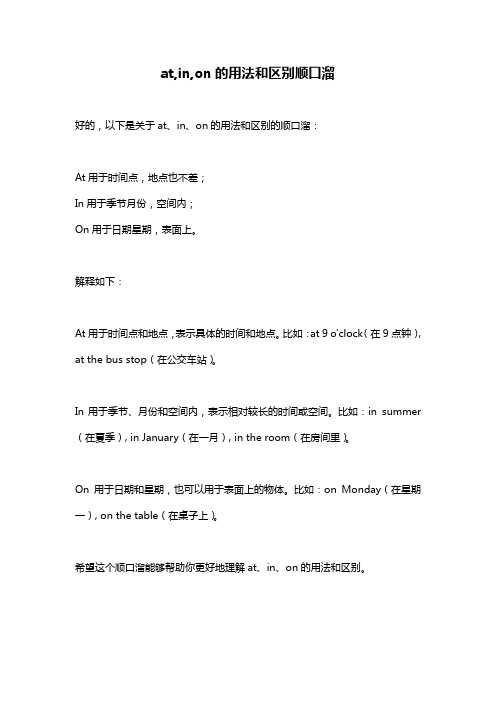
at,in,on的用法和区别顺口溜
好的,以下是关于at、in、on的用法和区别的顺口溜:
At用于时间点,地点也不差;
In用于季节月份,空间内;
On用于日期星期,表面上。
解释如下:
At用于时间点和地点,表示具体的时间和地点。
比如:at 9 o'clock(在9点钟), at the bus stop(在公交车站)。
In用于季节、月份和空间内,表示相对较长的时间或空间。
比如:in summer (在夏季), in January(在一月), in the room(在房间里)。
On用于日期和星期,也可以用于表面上的物体。
比如:on Monday(在星期一), on the table(在桌子上)。
希望这个顺口溜能够帮助你更好地理解at、in、on的用法和区别。
最新英语介词in、on、at等的用法大全

英语介词in、on、at等的用法大全“表时间的介词at、on、in到底怎么用?”,今天接着跟大家分享这三个介词表时间的用法。
一、at1、表示时刻,即几点几分(with particular points on the clock)I’ll see you at five o’clock. (我五点和你见面。
)2、表示一天中的某个时间段(with particular points in the day)The helicopter took off at midday and headed for the island. (直升机中午起飞,飞往那个岛屿。
)3、表示一周中的某个时间段,即工作日(weekday)和周末(weekend)(with particular points in the week)What are you doing at the weekend?4、表示某种特殊场合,如名字中不含day的节假日(with special celebrations)At the New Year, millions of people travel home to be with their families(到了新年,成百上千万的人会回到家里和家人团聚。
)例外情况:如果是说在生日那天,不用at,而用on,因为生日那天是指具体日期,请往下参考on 的用法。
【注意】如果是用what time来提问,what time前面一般不用at。
如:What time are you leaving? (你几点走?)但是在口语中也可以这么问:At what time are you leaving?二、on1、用在日期前(with dates)We moved into this house on 2 October 1997. (我们是1997年10月2日搬进这栋房子的。
)2、用在星期的单数前(with a singular day of the week to refer to one occasion)I’ve got to go to London on Friday. (我周五就到伦敦了。
介词in,on,at时间的用法总结
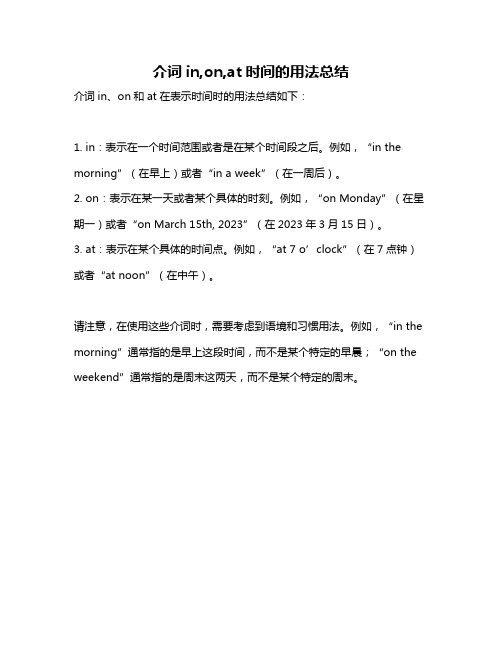
介词in,on,at时间的用法总结
介词in、on和at在表示时间时的用法总结如下:
1. in:表示在一个时间范围或者是在某个时间段之后。
例如,“in the morning”(在早上)或者“in a week”(在一周后)。
2. on:表示在某一天或者某个具体的时刻。
例如,“on Monday”(在星期一)或者“on March 15th, 2023”(在2023年3月15日)。
3. at:表示在某个具体的时间点。
例如,“at 7 o’clock”(在7点钟)或者“at noon”(在中午)。
请注意,在使用这些介词时,需要考虑到语境和习惯用法。
例如,“in the morning”通常指的是早上这段时间,而不是某个特定的早晨;“on the weekend”通常指的是周末这两天,而不是某个特定的周末。
at on in 跟时间的用法

at on in 跟时间的用法
在表示时间的用法中,我们使用 at、on、in 来指示不同的时间概念。
下面是它们的用法:
1. "at" 表示具体的时间点或某个特定的时刻。
例如:
- I have a meeting at 9 o'clock.(我有一个会议在九点。
)- She usually goes to bed at midnight.(她通常在午夜睡觉。
)
2. "on" 主要用于日期、星期几和节日等特定的日子。
例如:
- My birthday is on August 10th.(我的生日是在8月10日。
)
- We always have a family gathering on Christmas Day.(我们总是在圣诞节这一天举行家庭聚会。
)
3. "in" 用于表示一个时间段、月份、季节或年份等。
例如:
- I will go on vacation in July.(我将在七月去度假。
)- The flowers bloom in spring.(花朵在春天开放。
)
- He was born in 1990.(他出生于1990年。
)
需要注意的是,具体使用哪个词取决于所表达的时间概念,因此在具体场景中,可能需要根据语境来确定使用哪个词。
on in at的用法及区别口诀
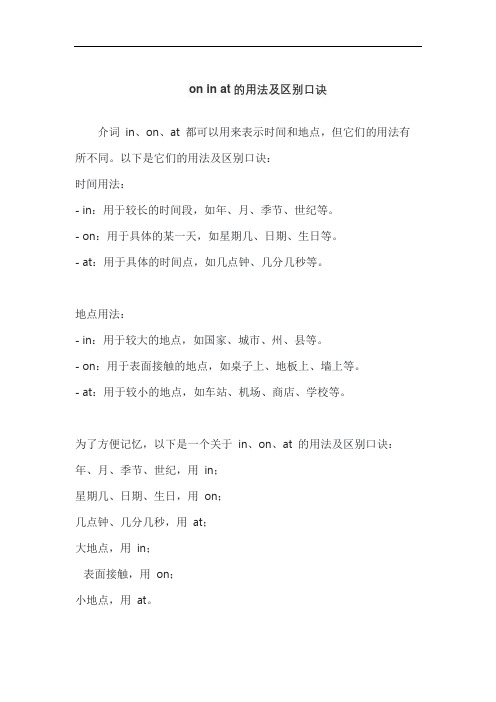
on in at的用法及区别口诀
介词in、on、at 都可以用来表示时间和地点,但它们的用法有所不同。
以下是它们的用法及区别口诀:
时间用法:
- in:用于较长的时间段,如年、月、季节、世纪等。
- on:用于具体的某一天,如星期几、日期、生日等。
- at:用于具体的时间点,如几点钟、几分几秒等。
地点用法:
- in:用于较大的地点,如国家、城市、州、县等。
- on:用于表面接触的地点,如桌子上、地板上、墙上等。
- at:用于较小的地点,如车站、机场、商店、学校等。
为了方便记忆,以下是一个关于in、on、at 的用法及区别口诀:年、月、季节、世纪,用in;
星期几、日期、生日,用on;
几点钟、几分几秒,用at;
大地点,用in;
表面接触,用on;
小地点,用at。
介词in,on,at的用法详解

介词in,on,at的用法详解1、表示时间的at,in,on:at表示片刻的时间,如:at8o'clock,at midnight,at the end of,at that time,at the beginning of, at the age of,at Christmas,at New Year等。
in表示一段的时间,如:in the morning,in the afternoon,in the evening,in October,in1998,in summer,in the past,in the future等。
on总是跟日子有关,如:on Monday,on Christmas morning,on the following,on May Day,on a warm morning等。
2、表示时间的since和from:since表示从过去到现在的一段时间的过程,常与现在完成时连用:from表示从时间的某一点开始,不涉及与现在的关系。
一般多与现在时、过去时、将来时连用。
如:I hope to do morning exercises from today./We have not seen each other since1995.3、表示时间的in和after:两者都表示“在(某个时间)之后,区别在于in表示“在(一段时间)之后”,而after则表示“在(某一具体时间点之后),in短语和将来时态连用,after短语和过去时态或将来时态连用。
如:We'll be back in three days./After seven the rain began to fall./What shall we do after graduation?After two months he returned.注意:after有时也可以表示在一段时间之后(常用在过去时里) 4、表示地理位置的in,on,to:in表示在某范围内,on指与什么毗邻,to指在某环境范围之外。
英语at、on、in等介词用法大全,快给孩子看看!

英语at、on、in等介词用法大全,快给孩子看看!(一)表示时间的介词:1.at, in ,on(1) at表示“在某一时刻、某一时点”(2)in表示“在某月、季节、年、世纪”以及泛指的上、下午、晚上。
in Septemberin winterin 1999in the 20th centuryin the morning/afternoon/evening(3)on表示“在具体某一天或某天的上、下午”。
但若指具体某一天的上述时段时,则一律用on。
on Monday on April 1stOn the afternoon of May 23.2.from, since, for(1) from表示“等时间的起点”。
You can come anytime from Monday to Friday.The exam will start from 9:00am.(2) since表示“自从……以来(直到现在)”He has been away from home since 1973.他自从1973年就离开了家乡。
We have known each other since ten years ago.我们十年前就认识了。
(3) for 与since表示一段时间,但for与时间段连用,而since与时间点连用。
for two hours since last week3.after, in, within(1) after表示“在……之后”,是before的反义词。
We’ll hold a party after dinner.晚餐后我们将举办晚会。
He got a cancer and died after a year.他患了癌症,一年后去世了(2) within“在……时间之内”I can finish it within an hour.我不需一小时就可把它做完。
(3) in 后面接过去的时间点表过去,若后面接一段时间,则表示“在……时间之后”I was born in 1983.我出生于1983年。
介词on in at的用法口诀
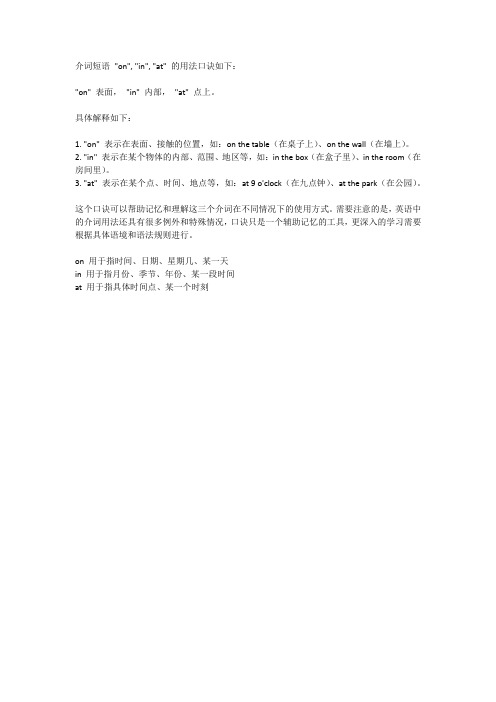
介词短语"on", "in", "at" 的用法口诀如下:
"on" 表面,"in" 内部,"at" 点上。
具体解释如下:
1. "on" 表示在表面、接触的位置,如:on the table(在桌子上)、on the wall(在墙上)。
2. "in" 表示在某个物体的内部、范围、地区等,如:in the box(在盒子里)、in the room(在房间里)。
3. "at" 表示在某个点、时间、地点等,如:at 9 o'clock(在九点钟)、at the park(在公园)。
这个口诀可以帮助记忆和理解这三个介词在不同情况下的使用方式。
需要注意的是,英语中的介词用法还具有很多例外和特殊情况,口诀只是一个辅助记忆的工具,更深入的学习需要根据具体语境和语法规则进行。
on 用于指时间、日期、星期几、某一天
in 用于指月份、季节、年份、某一段时间
at 用于指具体时间点、某一个时刻。
英语时间方位介词in,at,on详细图解,超有用
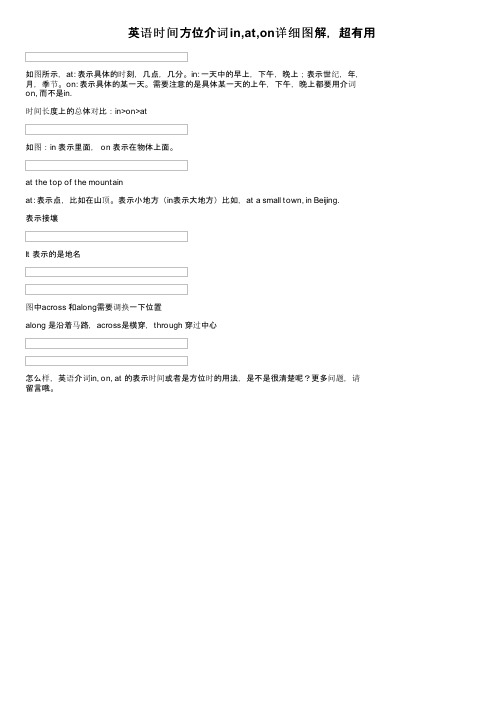
英语时间方位介词in,at,on详细图解,超有用如图所示,at: 表示具体的时刻,几点,几分。
in: 一天中的早上,下午,晚上;表示世纪,年,月,季节。
on: 表示具体的某一天。
需要注意的是具体某一天的上午,下午,晚上都要用介词on, 而不是in.
时间长度上的总体对比:in>on>at
如图:in 表示里面, on 表示在物体上面。
at the top of the mountain
at: 表示点,比如在山顶。
表示小地方(in表示大地方)比如,at a small town, in Beijing.
表示接壤
It 表示的是地名
图中across 和along需要调换一下位置
along 是沿着马路,across是横穿,through 穿过中心
怎么样,英语介词in, on, at 的表示时间或者是方位时的用法,是不是很清楚呢?更多问题,请
留言哦。
in、on、at的时间用法和地点用法(史上最全版)

i n,o n,a t的时间用法和地点用法一、in,on,at的时间用法1、固定短语:inthemorning/afternoon/evening在早晨/下午/傍晚,atnoon/night在中午/夜晚,(不强调范围,强调的话用duringthenight)earlyinthemorning=intheearlymorning在大清早,lateatnight在深夜ontheweekend在周末(英式用attheweekend在周末,atweekends每逢周末)onweekdays/weekends在工作日/周末,onschooldays/nights在上学日/上学的当天晚上,2、不加介词this,that,last,next,every,one,yesterday,today,tomorrow,tonight,all,most等之前一般不加介词。
如,thismorning今天早晨(on)thatday在那天(thatday更常用些)lastweek上周nextyear明年thenextmonth第二个月(以过去为起点的第二个月,nextmonth以现在为起点的下个月)everyday每天onemorning一天早晨yesterdayafternoon昨天下午tomorrowmorning明天早晨allday/morning/night整天/整个早晨/整晚(等于thewholeday/morning/night)mostofthetime(在)大多数时间3、一般规则除了前两点特殊用法之外,其他≤一天,用on,>一天用in,在具体时刻或在某时用at(不强调时间范围)关于onOn指时间表示:1)具体的时日和一个特定的时间,如某日,某节日,星期几等。
Hewillcometomeetusonourarrival.OnMay4th(OnSunday,OnNewYear’sday,OnChristmasDay),therewillbeacelebration. 2)在某个特定的早晨,下午或晚上。
介词at,in与on的用法与区别
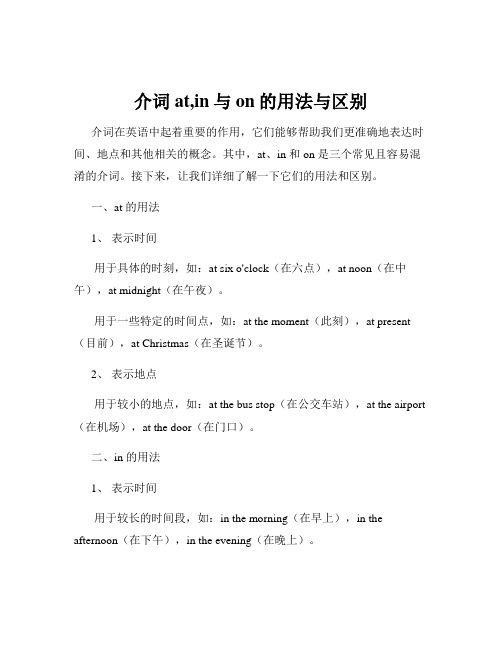
介词at,in与on的用法与区别介词在英语中起着重要的作用,它们能够帮助我们更准确地表达时间、地点和其他相关的概念。
其中,at、in 和 on 是三个常见且容易混淆的介词。
接下来,让我们详细了解一下它们的用法和区别。
一、at 的用法1、表示时间用于具体的时刻,如:at six o'clock(在六点),at noon(在中午),at midnight(在午夜)。
用于一些特定的时间点,如:at the moment(此刻),at present (目前),at Christmas(在圣诞节)。
2、表示地点用于较小的地点,如:at the bus stop(在公交车站),at the airport (在机场),at the door(在门口)。
二、in 的用法1、表示时间用于较长的时间段,如:in the morning(在早上),in the afternoon(在下午),in the evening(在晚上)。
用于月份、季节、年份,如:in May(在五月),in summer(在夏天),in 2023(在 2023 年)。
用于表示“在期间”,如:in the past few years(在过去的几年里),in the future(在未来)。
2、表示地点用于较大的地点,如:in Beijing(在北京),in China(在中国),in the city(在城市里)。
用于表示在里面,如:in the room(在房间里),in the box(在盒子里)。
三、on 的用法1、表示时间用于具体的日期,如:on Monday(在星期一),on May 1st(在五月一日),on Christmas Day(在圣诞节当天)。
用于表示在某一天的上午、下午或晚上,如:on the morning of June 1st(在六月一日的上午),on a cold evening(在一个寒冷的晚上)。
at on in用法归纳
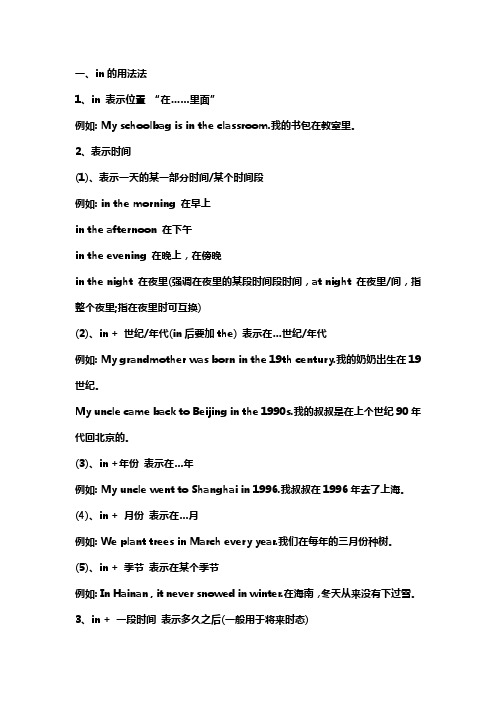
一、in的用法法1、in 表示位置“在……里面”例如: My schoolbag is in the classroom.我的书包在教室里。
2、表示时间(1)、表示一天的某一部分时间/某个时间段例如: in the morning 在早上in the afternoon 在下午in the evening 在晚上,在傍晚in the night 在夜里(强调在夜里的某段时间段时间,at night 在夜里/间,指整个夜里;指在夜里时可互换)(2)、in + 世纪/年代(in后要加the) 表示在…世纪/年代例如: My grandmother was born in the 19th century.我的奶奶出生在19世纪。
My uncle came back to Beijing in the 1990s.我的叔叔是在上个世纪90年代回北京的。
(3)、in +年份表示在…年例如: My uncle went to Shanghai in 1996.我叔叔在1996年去了上海。
(4)、in + 月份表示在…月例如: We plant trees in March every year.我们在每年的三月份种树。
(5)、in + 季节表示在某个季节例如: In Hainan , it never snowed in winter.在海南,冬天从来没有下过雪。
3、in + 一段时间表示多久之后(一般用于将来时态)例如:I will be back from Beijing in two days.我两天后从北京回来。
(表示从现在起多久以后)4、in + 语言表示用…语言或用…语言说/写例如:What's this in English? 这个用英语怎么说?He is writing a letter to his father in Chinese.他正在用中文给他父亲写信。
Can you say it in English? 你能用英语说吗?5、in + 颜色/衣服表示穿什么(颜色)的衣服例如: The girl in red is my sister.那位穿红色衣服的女孩是我的妹妹。
on_in_at_日期的用法口诀大于一天
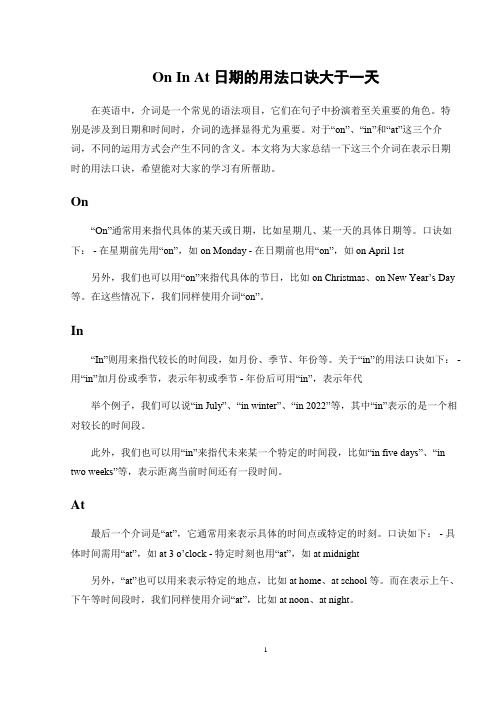
On In At 日期的用法口诀大于一天在英语中,介词是一个常见的语法项目,它们在句子中扮演着至关重要的角色。
特别是涉及到日期和时间时,介词的选择显得尤为重要。
对于“on”、“in”和“at”这三个介词,不同的运用方式会产生不同的含义。
本文将为大家总结一下这三个介词在表示日期时的用法口诀,希望能对大家的学习有所帮助。
On“On”通常用来指代具体的某天或日期,比如星期几、某一天的具体日期等。
口诀如下: - 在星期前先用“on”,如on Monday - 在日期前也用“on”,如on April 1st 另外,我们也可以用“on”来指代具体的节日,比如on Christmas、on New Year’s Day 等。
在这些情况下,我们同样使用介词“on”。
In“In”则用来指代较长的时间段,如月份、季节、年份等。
关于“in”的用法口诀如下: - 用“in”加月份或季节,表示年初或季节 - 年份后可用“in”,表示年代举个例子,我们可以说“in July”、“in winter”、“in 2022”等,其中“in”表示的是一个相对较长的时间段。
此外,我们也可以用“in”来指代未来某一个特定的时间段,比如“in five days”、“in two weeks”等,表示距离当前时间还有一段时间。
At最后一个介词是“at”,它通常用来表示具体的时间点或特定的时刻。
口诀如下: - 具体时间需用“at”,如at 3 o’clock - 特定时刻也用“at”,如at midnight另外,“at”也可以用来表示特定的地点,比如at home、at school等。
而在表示上午、下午等时间段时,我们同样使用介词“at”,比如at noon、at night。
通过掌握“on”、“in”和“at”这三个介词在表示日期时的用法口诀,我们可以更加准确地表达时间和日期信息,避免在语言交流中出现误解。
希望以上总结能够帮助大家更好地理解这三个介词在日期表示上的用法差异。
in on at介词用法
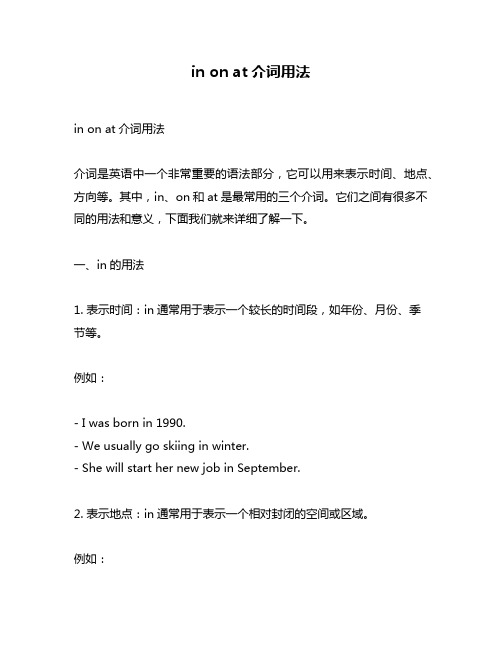
in on at介词用法in on at介词用法介词是英语中一个非常重要的语法部分,它可以用来表示时间、地点、方向等。
其中,in、on和at是最常用的三个介词。
它们之间有很多不同的用法和意义,下面我们就来详细了解一下。
一、in的用法1. 表示时间:in通常用于表示一个较长的时间段,如年份、月份、季节等。
例如:- I was born in 1990.- We usually go skiing in winter.- She will start her new job in September.2. 表示地点:in通常用于表示一个相对封闭的空间或区域。
例如:- He is in the office now.- The cat is hiding in the box.- There are many books in the library.3. 表示状态:in还可以用于表示某种状态或情况。
例如:- She is in a good mood today.- He is interested in learning Chinese.- They are all in trouble now.4. 表示方式:in还可以与一些动词搭配使用,表示某种方式或方法。
例如:- She wrote the letter in English.- He solved the problem in his own way.- They learned to dance in a traditional style.二、on的用法1. 表示时间:on通常用于表示具体某一天或某个特定日期。
例如:- We will have a party on Saturday night.- My birthday is on June 12th.- The concert will be on Christmas Day.2. 表示地点:on通常用于表示一个平面或表面。
in on at 表时间的用法

in on at 表时间的用法一、in的用法1. 表示“在……之内”例如:in a week(一周之内)、in a month(一个月之内)2. 表示“在……时”例如:in the morning(早上)、in the afternoon(下午)、in the evening(晚上)3. 表示“在某个时刻之后”例如:in an hour(一个小时后)、in a minute(一分钟后)4. 表示“在某段时间内”例如:in the 1990s(20世纪90年代)、in the summer(夏季)二、on的用法1. 表示“在某个具体日期”例如:on June 1st(6月1日)、on Christmas Day(圣诞节)2. 表示“在某个具体星期几”例如:on Monday(星期一)、on Friday night(周五晚上)3. 表示“在某个具体节日”例如:on New Year's Day(元旦)、on Easter Sunday(复活节星期日)三、at的用法1. 表示“在某个具体时刻”例如:at 9 o'clock(9点钟)、at noon(中午12点钟)2. 表示“在某个具体地点”例如:at home(在家里)、at school(在学校)3. 表示“在某个具体事件发生的时间或地点”例如:at the party last night (昨晚的派对上)、at the airport (在机场)四、常见搭配及注意事项1. in的常见搭配有:in the morning/afternoon/evening(早上/下午/晚上)、in a week/month/year(一周/一个月/一年之内)、in the 1990s(20世纪90年代)2. on的常见搭配有:on Monday/Tuesday/Wednesday(星期一/二/三)、on Christmas Day/New Year's Day(圣诞节/元旦)3. at的常见搭配有:at 9 o'clock/midnight(9点钟/午夜)、at home/school/work(在家里/学校/工作地点)4. 注意事项:① 表示“在某个具体日期”时,用on,而不是in或at。
at、on和in在表示时间上的用法

at、on和in在表示时间上的用法英语中表示时间的时候,经常会用到at、on和in,但是什么时候用哪个词,大家还是要引起注意。
这里我们把这几个词的用法和大家一起总结一下:一、at1、在小到点钟的具体时间,比如:We are going to have meeting at three o'clock.She usually has breakfast at seven.2、在noon,weekend,night,sunrise等词的前面,比如:The policemen still work at noon.We will have a farewell party for Richel at this weekend.3、在节日的前面,表示节日期间,比如:Traditionally, Chinese people will go back home at Spring Festival.Americans always have a lot of fun at Chrismas.二、on1、用于星期几、几号等时间前,比如:I'm to take the flight 2355 on Monday.We have dicided to visit our teacher on 26th May.2、用于特定的时间点,以及weekend,比如:on Christmas Eve/Day三、in1、用在世纪、年份、月份、春夏秋冬、早上、晚上前面,比如:in 2017in Augustin summerin the mornign2、在周一早上,根据就近原则,要用on Monday Morning,或者in the morning of Monday在一个炎热的下午,要用on a hot afternoon。
这些是常见的一些用法,供大家参考。
on,in,at的用法

on,in,at的用法一、"On, In, At"的用法简介"On, In, At"是英语中常用的介词,用于表示时间、地点和位置。
这三个词的用法常常成为非英语母语学习者困惑的问题,因为在不同的情境下它们具有不同的含义和适用性。
本文将详细介绍这三个介词在不同场合下的正确使用方法。
二、表示时间的用法2.1 "On"的用法:- "On"用于指定具体日期或星期几。
例如:on Monday(星期一),on June 5th (6月5日)。
- "On"还可以与某些特定节日连用,如:on New Year's Day(元旦)、on Christmas(圣诞节)等。
2.2 "In"的用法:- "In"通常与较长时间段连用,例如:in May(五月)、in the morning(早上)。
- "In"也可与一些具体时刻连用,如:in 1990(1990年),in the evening(晚上)。
2.3 "At"的用法:- "At"主要与特定时刻搭配,例如:at 3 o'clock(3点钟)、at noon(中午)。
- "At"还可以与称谓相连,如:at sunrise(日出)、at bedtime(睡觉时间)。
三、表示地点和位置的用法3.1 "On"的用法:- "On"用于表达物体位于平面或表面之上,例如:on the table(在桌子上)、on the wall(在墙上)。
3.2 "In"的用法:- "In"用于表示物体位于一个封闭的空间内,例如:in the box(在盒子里)、in the room(在房间里)。
- 1、下载文档前请自行甄别文档内容的完整性,平台不提供额外的编辑、内容补充、找答案等附加服务。
- 2、"仅部分预览"的文档,不可在线预览部分如存在完整性等问题,可反馈申请退款(可完整预览的文档不适用该条件!)。
- 3、如文档侵犯您的权益,请联系客服反馈,我们会尽快为您处理(人工客服工作时间:9:00-18:30)。
介词in,on与at表时间的用法
at < 天(eg. noon, dawn, night, one’ clock)
on = 天(Monday, 30th June, New Year’s Day, Mother’s Day)
in > 天(2008, summer, April, 还有早午晚)
用in的场合后所接的都是较长时间
(1)表示“在某世纪/某年代/特定世纪某年代/年/季节/月”这个含义时,须用介词in
Eg: This machine was invented in the eighteenth century. 这台机器是在18世纪发明的。
This incident happened in the 1970s. 该事件发生在20世纪70年代。
She came to this city in 1980. 他于1980年来到这个城市。
It often rains here in summer. 夏天这里常常下雨。
(2)表示“从现在起一段时间以后”时,须用介词in。
(in+段时间表将来)
Eg: They will go to see you in a week. 他们将在一周后去看望你。
I will be back in a month. 我将在一个月后回来。
(3)泛指一般意义的上、下午、晚上用in, in the morning / evening / afternoon
Eg: They sometimes play games in the afternoon. 他们有时在下午做游戏。
Don't watch TV too much in the evening. 晚上看电视不要太多。
(4)A. 当morning, evening, afternoon被of短语修饰,习惯上应用on, 而不用in.
Eg: on the afternoon of August 1st
(5)B. 但若前面的修饰词是early, late时,虽有of短语修饰,习惯上应用in, 而不用on.
Eg: in the early morning of September 10th 在9月10的清晨;
in the late afternoon of September 12th 在9月12日的傍晚。
Early in the morning of National Day, I got up to catch the first bus to the zoo.
国庆节一清早,我便起床去赶到动物园的第一班公共汽车。
用on的场合后所接的时间多与日期有关
(1)表示“在具体的某一天”或(在具体的某一天的)早上、中午、晚上”,或“在某一天或
某一天的上午,下午,晚上”等,须用介词on。
Eg: Jack was born on May 10th, 1982. 杰克生于1982年5月10日。
They left on a rainy morning. 他们是在一个雨天的早上离开的。
He went back to America on a summer afternoon. 他于一个夏天的下午返回了美国。
(2)表示“在星期几”或“在星期几的早上、中午、晚上”等,须用介词on。
Eg: We don't go to school on Saturday and Sunday. 我们星期六和星期
天不上学。
What time do you get up on weekdays? 你在平日什么时候起床?
I heard this story on Saturday morning. 我是在星期六的早晨听到这个
故事的。
【温馨提示】“在周末”: at weekends, on weekends. “在工作日”是on weekdays on the weekend, at the weekend加了定冠词the, 是特指的那个周末,表示某个固定的周末;
on weekends, at weekends是一般性的每个周末。
美国英语习惯使用on: on weekends 把周末看作星期同类,因为无论星期几都用on, 这样是对的;英国英语习惯用at: at weekends 把周末看作节假日,自然也是对的。
(3)表示“在某一节假日、生日”时,须用介词on。
Eg: on my birthday
Mr Hu received a card on Teachers' Day. 胡老师在教师节那天收到了一
张卡片。
We usually eat mooncakes on Mid-autumn Festival. 我们通常在中秋节吃月饼。
【温馨提示】at, on都可用来表示“节假日”,但at侧重指“休假的时节”,而不是指具体的哪一天;on侧重指具体的时日,与它连用的短语中多含“Day”
at New Year(在新年期间) at Christmas (在圣诞节期间)
on New Year’s Day(在元旦那天) on Christmas Day (在圣诞节)
用at的场合后接的时间最短
(1)表示“某一具体时刻(即几点几分时)”时,用于钟点时刻前,须用介词at。
Eg: at ten o’clock, at a quarter to six
He gets up at six o'clock every day. 他每天六点起床。
I got home at five thirty yesterday afternoon. 我昨天下午五点半到家。
(2)用在特定的时候(时节、时机)时,须用介词at, 表示一瞬间或短暂的时间
Eg: They were happy at that time. 他们那时很幸福。
I think the shop is clcsed at this time of day. 我认为商店在白天的这个时候关门了。
at that moment(在那一瞬间)at that time(那时)
(3)用于表示进餐时间。
Eg: at breakfast/lunch/supper (在早餐时/午餐时/晚餐时)
He drinks tea at breakfast. 他在早餐时饮茶。
(4)表示“在……岁”时,须用介词at。
Eg: At the age of nine ,the boy could swim well.在九岁的时候,这孩子就游泳游得很好了。
(5)表示“在中午、在夜晚、在周末”时,须用介词at。
Eg: at noon /night /midnight (半夜), at sunrise (日出时)
at dusk (黄昏), at dawn /daybreak (黎明)
What do you often do at noon? 你中午经常做些什么?
You can see many stars in the sky at night. 夜晚你能看到天空中有许多星星。
省略介词的情况
1.next, last, this, that与时间名词连用作状语时,该短语前常省略介词。
Eg: We’re going to work on a farm next Sunday.下个星期天,我们要去农场劳动。
They visited the Great Wall last year. 去年他们参观了长城。
2.在today, tomorrow, yesterday, the day before yesterday, the day after tomorrow, tomorrow night 等之前不用任何介词。
Eg: Are you free tomorrow night? 明晚你有空吗?
Where did you go the day before yesterday? 前天你去哪儿了?
注意:在含有next, last, this, one, any, each, every, some, all等修饰时和tomorrow, yesterday, the day after tomorrow, the day before yesterday 前不用任何介词。
Eg: What did you do last summer holidays? 去年暑假你做了些什么?
What are you going to do the day after tomorrow? 后天你打算做什么?。
